|
|
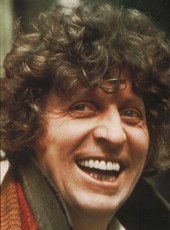 |
|
The
Fourth Doctor
(1974 - 1981 & 1983) |
|
|
|
|
|
|
The
Sound Vault |
|
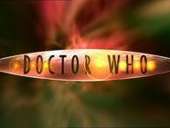 |
|
 |
|
| Leela |
|
|
The Best Doctor
|
| |
| Vote
if I am your favourite Doctor |
|
|
|
|
|
 If
you ask a casual viewer to describe The Doctor, there's a good
chance the Fourth Doctor would be chosen. With his mop of curly
brown hair, broad toothy grin and his slightly scruffy outlandish
attire, with was exaggerated by his incredibly long multicoloured
trailing scarf, floppy wide brimmed hat, virtually bottomless
pockets - a potentially not untrue fact, given the Tenth
Doctor’s
comment about the pockets being just as dimensionally transcendental
as the TARDIS itself - and a burgundy baggy jacket the Fourth
Doctor was the most visually imposing of them all. If
you ask a casual viewer to describe The Doctor, there's a good
chance the Fourth Doctor would be chosen. With his mop of curly
brown hair, broad toothy grin and his slightly scruffy outlandish
attire, with was exaggerated by his incredibly long multicoloured
trailing scarf, floppy wide brimmed hat, virtually bottomless
pockets - a potentially not untrue fact, given the Tenth
Doctor’s
comment about the pockets being just as dimensionally transcendental
as the TARDIS itself - and a burgundy baggy jacket the Fourth
Doctor was the most visually imposing of them all.
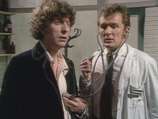 |
| Robot |
|
 His debut scene, just after his regeneration, is very reminiscent to Jon Pertwee's as
he was seen wandering around in a nightshirt looking for his TARDIS.
He even found the TARDIS key hidden in his shoe! But despite this
similarity the Fourth Doctor was very different from his predecessors
even though he possessed many characteristics from his former incarnations,
most notably his second incarnation’s habit of making jokes
and acting the fool to put his foes off-guard. At times he seemed
to be unreliable and with his wide eyed penetrating stare those around
him did not know at times if they could trust him or not. He had
a strange mixture of contradictory qualities and he had a tendency
to be very spontaneous with a bubbling eccentric vitality, rapidly
shifting between casually commenting that Morbius wasn’t all
there any more - Morbius having been reduced to a brain when he was
nearly executed - before coldly challenging him to a mind-wrestling
contest ("The
Brain of Morbius"). He could be very cold,
impersonal and rather aloof and then a moment later he would be brimming
with enthusiasm for life. His debut scene, just after his regeneration, is very reminiscent to Jon Pertwee's as
he was seen wandering around in a nightshirt looking for his TARDIS.
He even found the TARDIS key hidden in his shoe! But despite this
similarity the Fourth Doctor was very different from his predecessors
even though he possessed many characteristics from his former incarnations,
most notably his second incarnation’s habit of making jokes
and acting the fool to put his foes off-guard. At times he seemed
to be unreliable and with his wide eyed penetrating stare those around
him did not know at times if they could trust him or not. He had
a strange mixture of contradictory qualities and he had a tendency
to be very spontaneous with a bubbling eccentric vitality, rapidly
shifting between casually commenting that Morbius wasn’t all
there any more - Morbius having been reduced to a brain when he was
nearly executed - before coldly challenging him to a mind-wrestling
contest ("The
Brain of Morbius"). He could be very cold,
impersonal and rather aloof and then a moment later he would be brimming
with enthusiasm for life.
 He had a brilliant scientific mind and he liked to demonstrate his
enormous wealth of knowledge and past experiences. But at the same
time he could be humorous and act like a buffoon and his basic approach
to a new situation would be to walk boldly into them and say with
abroad grin 'Hello, I'm The Doctor'. This habit of undermining his
enemies by acting nonchalant when facing them persisted throughout
his incarnations; even when facing such foes as a demonic life-form
that sought to unleash a destructive force of chaos upon the universe
("Heart
of TARDIS"), The Doctor simply casually pointed
out the flaws in its plan. His whimsical sense of humour and unpredictability
meant that you could never tell when he would suddenly whip out of
his pocket a bag of Jelly Babies or his yo-yo. He had a brilliant scientific mind and he liked to demonstrate his
enormous wealth of knowledge and past experiences. But at the same
time he could be humorous and act like a buffoon and his basic approach
to a new situation would be to walk boldly into them and say with
abroad grin 'Hello, I'm The Doctor'. This habit of undermining his
enemies by acting nonchalant when facing them persisted throughout
his incarnations; even when facing such foes as a demonic life-form
that sought to unleash a destructive force of chaos upon the universe
("Heart
of TARDIS"), The Doctor simply casually pointed
out the flaws in its plan. His whimsical sense of humour and unpredictability
meant that you could never tell when he would suddenly whip out of
his pocket a bag of Jelly Babies or his yo-yo.
 He
had more of an alien detachment and this was perfectly demonstrated
during an attempted return, in the TARDIS, to UNIT when his companion, Sarah
Jane Smith, chastises him for his pensive mood and that he
should be happy about returning home. His reply to her was 'The Earth
isn't my home, Sarah. I'm a Time Lord… You don't understand
the implications. I'm not a Human being. I walk in eternity' ("Pyramids
of Mars"). Despite his occasionally detached attitude, he seemed to
sympathise with humanity more than he had in past incarnations, praising
humanity’s indomitability in "The
Ark in Space",
and seeming almost reluctant when he told the mutating Professor
Sorenson that death was the only ‘cure’ for his condition
("Planet
of Evil"); indeed, it was this incarnation that
first specifically stated that Earth was his favourite planet and
humanity his favourite species, no matter how he might find their
minds limited at times. He
had more of an alien detachment and this was perfectly demonstrated
during an attempted return, in the TARDIS, to UNIT when his companion, Sarah
Jane Smith, chastises him for his pensive mood and that he
should be happy about returning home. His reply to her was 'The Earth
isn't my home, Sarah. I'm a Time Lord… You don't understand
the implications. I'm not a Human being. I walk in eternity' ("Pyramids
of Mars"). Despite his occasionally detached attitude, he seemed to
sympathise with humanity more than he had in past incarnations, praising
humanity’s indomitability in "The
Ark in Space",
and seeming almost reluctant when he told the mutating Professor
Sorenson that death was the only ‘cure’ for his condition
("Planet
of Evil"); indeed, it was this incarnation that
first specifically stated that Earth was his favourite planet and
humanity his favourite species, no matter how he might find their
minds limited at times.
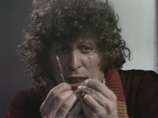 |
| Genesis of the Daleks |
|
 His
consistently ‘larger-than-life’ attitude towards
his adventures makes it somewhat apt that it was this Doctor rather
than any other that was selected to acquire the powerful artefact
known as the Key To Time to restore order to the universe, pitting
him against The
Black Guardian of the universe itself. Even when
he finally came face-to-face with this powerful foe, The Doctor remained
casual when confronting him, nonchalantly informing The Black Guardian
- after he tried to acquire the Key to Time by posing as his White
counterpart - that it would be a shame to doom the universe because
he was colour-blind, with only the installation of a randomiser -
a device that fed random co-ordinates into the TARDIS, thus making
it impossible for The Black Guardian to track the ship - serving
as a sign of how seriously he took The Black Guardian’s threat
to find him. On another occasion The Doctor spent some time in the
parallel universe of E-space - a counterpart to our own reality where
coordinates were negative and space was slightly smaller - granting
him a unique opportunity to explore and help a universe other than
his own for the first time ("Full
Circle", "State
of Decay", "Warrior’s Gate"), although he still
sought to return to his own universe due to his recognition of his
responsibilities in that reality. His
consistently ‘larger-than-life’ attitude towards
his adventures makes it somewhat apt that it was this Doctor rather
than any other that was selected to acquire the powerful artefact
known as the Key To Time to restore order to the universe, pitting
him against The
Black Guardian of the universe itself. Even when
he finally came face-to-face with this powerful foe, The Doctor remained
casual when confronting him, nonchalantly informing The Black Guardian
- after he tried to acquire the Key to Time by posing as his White
counterpart - that it would be a shame to doom the universe because
he was colour-blind, with only the installation of a randomiser -
a device that fed random co-ordinates into the TARDIS, thus making
it impossible for The Black Guardian to track the ship - serving
as a sign of how seriously he took The Black Guardian’s threat
to find him. On another occasion The Doctor spent some time in the
parallel universe of E-space - a counterpart to our own reality where
coordinates were negative and space was slightly smaller - granting
him a unique opportunity to explore and help a universe other than
his own for the first time ("Full
Circle", "State
of Decay", "Warrior’s Gate"), although he still
sought to return to his own universe due to his recognition of his
responsibilities in that reality.
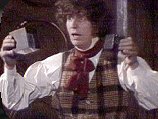 |
| The Robots of Death |
|
 As
with all Doctors, he was never cruel or cowardly, and when required
he had a lot of warmth and charm. The Doctor was ready to risk his
life for a worthy cause especially against tyranny and oppression
and he would never give in however overwhelming the odds were stacked
against him; shortly after his regeneration he rapidly disarmed a
computer set to fire nuclear missiles all over the world in under
half a minute, casually talking as he entered the codes seemingly
by chance ("Robot"),
and even standing up to such powerful foes as the god-like Sutekh
("Pyramids of Mars") and Valdemar ("Tomb
of Valdemar ") despite the overwhelming power his
opponents could use against him. He believed in good and was always
ready to fight evil but he would always attempt to defeat his enemies
and approach problems with contemplation and diplomacy rather than
using physical action which made him seem a bit detached. His character
did however, change over time and he did become more physical in
his approach so making Harry
Sullivan’s character virtually
redundant. His more violent enemies and his increased aggression
was first demonstrated during "The
Sontaran Experiment" when
The Doctor challenges Field Marshal Styre to an unarmed combat so
as to distract him so allowing Harry to sabotage the Sontaran's
space ship. As
with all Doctors, he was never cruel or cowardly, and when required
he had a lot of warmth and charm. The Doctor was ready to risk his
life for a worthy cause especially against tyranny and oppression
and he would never give in however overwhelming the odds were stacked
against him; shortly after his regeneration he rapidly disarmed a
computer set to fire nuclear missiles all over the world in under
half a minute, casually talking as he entered the codes seemingly
by chance ("Robot"),
and even standing up to such powerful foes as the god-like Sutekh
("Pyramids of Mars") and Valdemar ("Tomb
of Valdemar ") despite the overwhelming power his
opponents could use against him. He believed in good and was always
ready to fight evil but he would always attempt to defeat his enemies
and approach problems with contemplation and diplomacy rather than
using physical action which made him seem a bit detached. His character
did however, change over time and he did become more physical in
his approach so making Harry
Sullivan’s character virtually
redundant. His more violent enemies and his increased aggression
was first demonstrated during "The
Sontaran Experiment" when
The Doctor challenges Field Marshal Styre to an unarmed combat so
as to distract him so allowing Harry to sabotage the Sontaran's
space ship.
 However,
his violent confrontations became even more intense during latter
stories. In "The
Seeds of Doom" The Doctor is seen breaking a chair
over the head of one of his adversaries and he was even seen
wielding a conventional gun; even the Third Doctor had only
ever wielded energy weapons rather than weapons that fired bullets.
Also in "The
Deadly Assassin" he is again seen in hand-to-hand combat,
fighting the renegade Chancellor Goth, who was currently allied
with The Master.
However, his taste for hand-to-hand waned in later stories,
with most physical danger being defeated by the warrior Leela and K9’s
nose laser, although he retained sharp enough reflexes to outdraw
genetically engineered sharpshooter Redfearn despite only being
armed with his scarf ("Tomb of Valdemar"). Throughout
his life, the only constant thing about The Doctor’s personality
was that he would never be consistent throughout his adventures;
although jovial throughout the events of "Nightmare
of Eden", when he learned that a scientist was trading
in a dangerous drug, he refused to even look at the man when
he tried to justify his actions, and cheerfully describing Scorby
as a ‘mindless plant’ in "The Seeds of Doom" despite
his sombre attitude for most of the adventure in question. However,
his violent confrontations became even more intense during latter
stories. In "The
Seeds of Doom" The Doctor is seen breaking a chair
over the head of one of his adversaries and he was even seen
wielding a conventional gun; even the Third Doctor had only
ever wielded energy weapons rather than weapons that fired bullets.
Also in "The
Deadly Assassin" he is again seen in hand-to-hand combat,
fighting the renegade Chancellor Goth, who was currently allied
with The Master.
However, his taste for hand-to-hand waned in later stories,
with most physical danger being defeated by the warrior Leela and K9’s
nose laser, although he retained sharp enough reflexes to outdraw
genetically engineered sharpshooter Redfearn despite only being
armed with his scarf ("Tomb of Valdemar"). Throughout
his life, the only constant thing about The Doctor’s personality
was that he would never be consistent throughout his adventures;
although jovial throughout the events of "Nightmare
of Eden", when he learned that a scientist was trading
in a dangerous drug, he refused to even look at the man when
he tried to justify his actions, and cheerfully describing Scorby
as a ‘mindless plant’ in "The Seeds of Doom" despite
his sombre attitude for most of the adventure in question.
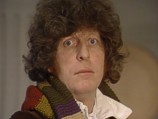 |
| The Invasion of Time |
|
 The
Fourth Doctor had twelve different companions, some of the most
that has ever been possessed by a Doctor. (Not counting those
occasions where Doctors have briefly encountered old companions
without their old friends actually resuming travelling with
them). Of these K9 was the first mechanical companion and Leela
was the first "alien" since The Doctor's very first
companion, Susan.
The Doctor was very protective towards his companions especially
Sarah Jane Smith. Even though Sarah thought that she could stand
up for herself The Doctor soon realised that she needed a bit
of protection. And The Doctor in his own way was able to protect
and comfort her 'The worse the situation, the worse your jokes
get' she commented once. Regardless of the occasional tension
between them, when Sarah later met the Tenth Doctor some years
after her departure, she implied that she had fallen in love
with the Fourth, but recognised that nothing could ever come
of it even as she found it hard to move on after leaving him;
in her own words, ‘There was only ever one man for me,
and after him... nothing compared’. After Sarah Jane Smith
left, due to The Doctor having to return to his home planet
and humans currently being forbidden to travel there, there
was one story in which The Doctor had no companions at all (Done
on Tom Baker’s request to give him a chance to stand on
his own in the series). The
Fourth Doctor had twelve different companions, some of the most
that has ever been possessed by a Doctor. (Not counting those
occasions where Doctors have briefly encountered old companions
without their old friends actually resuming travelling with
them). Of these K9 was the first mechanical companion and Leela
was the first "alien" since The Doctor's very first
companion, Susan.
The Doctor was very protective towards his companions especially
Sarah Jane Smith. Even though Sarah thought that she could stand
up for herself The Doctor soon realised that she needed a bit
of protection. And The Doctor in his own way was able to protect
and comfort her 'The worse the situation, the worse your jokes
get' she commented once. Regardless of the occasional tension
between them, when Sarah later met the Tenth Doctor some years
after her departure, she implied that she had fallen in love
with the Fourth, but recognised that nothing could ever come
of it even as she found it hard to move on after leaving him;
in her own words, ‘There was only ever one man for me,
and after him... nothing compared’. After Sarah Jane Smith
left, due to The Doctor having to return to his home planet
and humans currently being forbidden to travel there, there
was one story in which The Doctor had no companions at all (Done
on Tom Baker’s request to give him a chance to stand on
his own in the series).
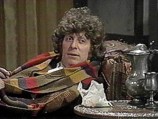 |
| The Ribos Operation |
|
 However,
this was soon rectified when he was joined in the TARDIS by Leela,
a leather-clad savage who lived on a planet where society’s
development had been manipulated by an insane supercomputer that
The Doctor had unintentionally created. Leela’s character led
to more violent confrontations against some of the monsters and villains
The Doctor faced, as her savage upbringing made her have a tendency
to kill first and then ask questions later. Despite his attempts
to civilise Leela, The Doctor soon realised that he was fighting
a losing battle, which was very frustrating for him as he continually
observed her tendency and preference to kill. Despite this, however,
the two of them became close, with The Doctor aware that he could
always rely on Leela to help him when he needed it - even coming
to enjoy teasing her about her more limited knowledge - and acknowledging
the benefits of her instinctive attitude when it allowed him to develop
a cure for the sentient virus known as the Swarm ("The
Invisible Enemy"). Despite their different backgrounds Leela’s loyalty
to The Doctor was unquestionable, to the extent that The Doctor was
once forced to banish her from his company when dealing with a race
of telepaths, as they might have sensed her devotion to him and realised
that he was lying to them ("The
Invasion of Time"). However,
this was soon rectified when he was joined in the TARDIS by Leela,
a leather-clad savage who lived on a planet where society’s
development had been manipulated by an insane supercomputer that
The Doctor had unintentionally created. Leela’s character led
to more violent confrontations against some of the monsters and villains
The Doctor faced, as her savage upbringing made her have a tendency
to kill first and then ask questions later. Despite his attempts
to civilise Leela, The Doctor soon realised that he was fighting
a losing battle, which was very frustrating for him as he continually
observed her tendency and preference to kill. Despite this, however,
the two of them became close, with The Doctor aware that he could
always rely on Leela to help him when he needed it - even coming
to enjoy teasing her about her more limited knowledge - and acknowledging
the benefits of her instinctive attitude when it allowed him to develop
a cure for the sentient virus known as the Swarm ("The
Invisible Enemy"). Despite their different backgrounds Leela’s loyalty
to The Doctor was unquestionable, to the extent that The Doctor was
once forced to banish her from his company when dealing with a race
of telepaths, as they might have sensed her devotion to him and realised
that he was lying to them ("The
Invasion of Time").
 During
this time a great deal more about the Time Lords was revealed and
he had two visits to his home planet Gallifrey. The first was when
he received a message calling him back but it turned out that this
was a trick by The
Master who wanted to involve The Doctor in an assassination plot
on the president. Falling into The Master's trap The Doctor soon
finds himself implicated by The Master and so inside the Matrix in
an attempt to not only prove his innocence but to also discover who
the real villain is. His second visit was caused by his attempt to
defeat the Vardans by aiding in their invasion - thus stopping a
less scrupulous Time Lord from helping them - but in doing so he
not only became the Lord President of the Time Lords - resulting
in him gaining temporary access to the Matrix itself, the source
of all Time Lord knowledge - but he also accidentally allowed a Sontaran
invasion force to penetrate Gallifrey's defences. During
this time a great deal more about the Time Lords was revealed and
he had two visits to his home planet Gallifrey. The first was when
he received a message calling him back but it turned out that this
was a trick by The
Master who wanted to involve The Doctor in an assassination plot
on the president. Falling into The Master's trap The Doctor soon
finds himself implicated by The Master and so inside the Matrix in
an attempt to not only prove his innocence but to also discover who
the real villain is. His second visit was caused by his attempt to
defeat the Vardans by aiding in their invasion - thus stopping a
less scrupulous Time Lord from helping them - but in doing so he
not only became the Lord President of the Time Lords - resulting
in him gaining temporary access to the Matrix itself, the source
of all Time Lord knowledge - but he also accidentally allowed a Sontaran
invasion force to penetrate Gallifrey's defences.
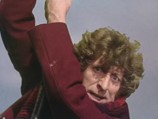 |
| Logopolis |
|
 Having
defeated the Sontarans and departed - leaving Leela and K9 on
the planet, although he later built a second K9 for company,
- The Doctor was subsequently joined in his travels by the young
Time Lady Romanadvoratrelundar, known as Romana for simplicity’s
sake, who provided a unique foil for The Doctor in being one
of the few companions who could at least equal The Doctor in
several areas (It was sometimes hinted that she could actually
surpass him in some fields, although his independent personality
still put him at an advantage in their adventures). Although
initially typically arrogant and convinced of her importance
in the grand scheme of things, Romana’s time with The
Doctor caused her to change and grow, leading to her regenerating
after the search for the Key to Time was completed to reflect
how she had become a new person in his company. Despite the
two forming a strong bond over the course of their travels together,
Romana eventually recognised that she needed to strike out on
her own, carving her own path away from the rest of Gallifreyian
civilisation, resulting in her leaving The Doctor to remain
in the ‘alternate universe’ of E-Space ("Warrior’s
Gate"). Having
defeated the Sontarans and departed - leaving Leela and K9 on
the planet, although he later built a second K9 for company,
- The Doctor was subsequently joined in his travels by the young
Time Lady Romanadvoratrelundar, known as Romana for simplicity’s
sake, who provided a unique foil for The Doctor in being one
of the few companions who could at least equal The Doctor in
several areas (It was sometimes hinted that she could actually
surpass him in some fields, although his independent personality
still put him at an advantage in their adventures). Although
initially typically arrogant and convinced of her importance
in the grand scheme of things, Romana’s time with The
Doctor caused her to change and grow, leading to her regenerating
after the search for the Key to Time was completed to reflect
how she had become a new person in his company. Despite the
two forming a strong bond over the course of their travels together,
Romana eventually recognised that she needed to strike out on
her own, carving her own path away from the rest of Gallifreyian
civilisation, resulting in her leaving The Doctor to remain
in the ‘alternate universe’ of E-Space ("Warrior’s
Gate").
 Nearer
to the end of the Fourth Doctor's era he was, at times, more
sombre and brooding, an attitude that was far from helped by
such confrontations as his battle with The
Repulsion (During
which he was briefly convinced that he was going to be forced
to sacrifice his life to save the day) ("Festival
of Death"),
or his confrontations with the amoral scientists Doctor Paddox
("Festival of Death"), Dexter ("Full Circle")
and Captain Rorvik ("Warrior’s Gate"), each
of whom experimented on more primitive species for their own
ends. His costume had also become darker and
more subdued, perhaps a hint that he was aware that his death
was coming soon, and that his attitude towards life reflected
his desire to cram as many experiences into his too-short long
life as he could. His fourth regeneration was caused while trying
to foil The Master's latest attempt to rule over the universe,
resulting in The Doctor falling from a deep space radio dish
when he tried to transmit a signal that would drain away the
entropy threatening the universe. Luckily for The Doctor this
event had already been prepared for when his companions witnessed
a mysterious being, who had been following them around, called
the Watcher merge with the dying Fourth Doctor just as he starts
to regenerate into the much younger looking Fifth Doctor. Nearer
to the end of the Fourth Doctor's era he was, at times, more
sombre and brooding, an attitude that was far from helped by
such confrontations as his battle with The
Repulsion (During
which he was briefly convinced that he was going to be forced
to sacrifice his life to save the day) ("Festival
of Death"),
or his confrontations with the amoral scientists Doctor Paddox
("Festival of Death"), Dexter ("Full Circle")
and Captain Rorvik ("Warrior’s Gate"), each
of whom experimented on more primitive species for their own
ends. His costume had also become darker and
more subdued, perhaps a hint that he was aware that his death
was coming soon, and that his attitude towards life reflected
his desire to cram as many experiences into his too-short long
life as he could. His fourth regeneration was caused while trying
to foil The Master's latest attempt to rule over the universe,
resulting in The Doctor falling from a deep space radio dish
when he tried to transmit a signal that would drain away the
entropy threatening the universe. Luckily for The Doctor this
event had already been prepared for when his companions witnessed
a mysterious being, who had been following them around, called
the Watcher merge with the dying Fourth Doctor just as he starts
to regenerate into the much younger looking Fifth Doctor.
|
|